QUESTIONS
- Name the tissues whose cells are thickened with:
- Cellulose and pectin (1 Mark)
- Lignin (1 Mark)
- The diagram below represents a fern.
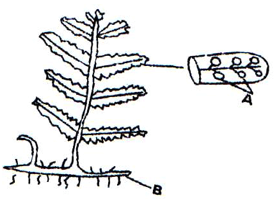
- Name parts labeled A and B (2 Marks)
A.........................
B......................... - To which division does the plant belong? (1 Mark)
- Name parts labeled A and B (2 Marks)
- State three measures that can be taken to control infection of man by protozoan parasites. (3 Marks)
- Explain how the following factors hinder self-pollination in plants:
- Protogyny (1 Mark)
- Dioecism (1 Mark)
- Explain the likely effect on humans and other organisms of untreated sewage discharged into water body that supplies water for domestic use. (2 Marks)
- State the structural adaptation of the mitochondrion. (2 Marks)
-
- Define the term immunity. (1 Mark)
- Distinguish between natural immunity and acquired immunity. (1 Mark)
- Identify one immunizable disease in Kenya. (1 Mark)
- State three differences between osmosis and active transport. (3 Marks)
- The diagram below illustrates part of a Nephron from a mammalian kidney.
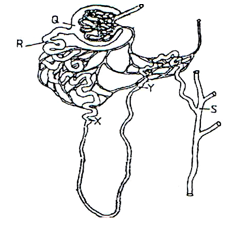
- Name the fluid found in the part labeled Q. (1 Mark)
- Identify the process responsible for the formation of the fluid named in (a) above. (1 Mark)
- Which two hormones exert their effect in the nephron? (2 Marks)
- State three characteristics of members of kingdom Monera that are not found in other kingdoms.(3 Marks)
- What is meant by the following biological terms?
- Crenation (1 Mark)
- Haemolysis (1 Mark)
- Plasmolysis (1 Mark)
- The diagram below shows a stage during fertilization in flowering plant.
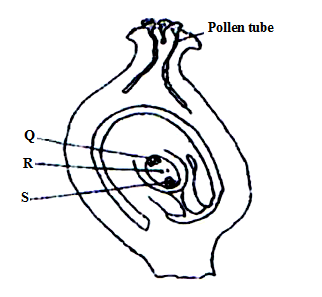
- Name the parts labeled Q, R and S. (3 Marks)
Q.………………………………………………..…………………………………………………..
R……………………………………………………………………………………………………..
S…………………………………………………………………………………………………….. - State the function of the pollen tube. (1 Mark)
- Name the parts labeled Q, R and S. (3 Marks)
-
- State the major factor in the ‘Global warming’ experienced in the world today.
- Suggest two ways of reducing Global warming. (2 Marks)
- Explain how the spread of malaria is controlled by the following methods.
- Applying oil on stagnant water. (2 Marks)
- Replacing male anopheles mosquito with sterile males. (2 Marks)
-
- Explain how the following adaptations of xerophytes assist them to survive in their habitat.
- Sunken stomata (1 Mark)
- Thick cuticle (1 Mark)
- State the structural differences between the root system of the xerophytes and that of the hydrophytes (2 Marks)
- Explain how the following adaptations of xerophytes assist them to survive in their habitat.
-
- Name a protein and vitamin involved in blood clotting.
- Protein (1 Mark)
- Vitamin (1 Mark)
- Explain why blood is not normally used for transfusion after one month. (1 Mark)
- Name a protein and vitamin involved in blood clotting.
- The diagram below is a demonstration of breathing mechanism in man.
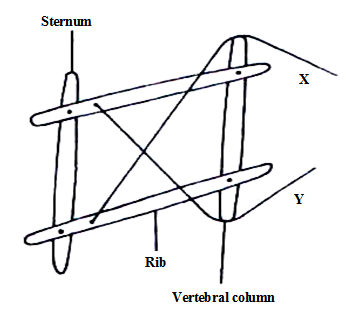
- What does the string X and Y represent (2 Marks)
- What is the effect of pulling string X (1 Mark)
- State two features in the insect pollinated flowers that encourage cross pollination. (2 Marks)
- The diagram below represents an experimental set up to investigate a certain scientific concept. The potted plant was first destarched by keeping it in dark for four days.
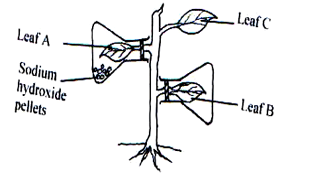
The set up was then placed in sunlight for five hours and leaves were tested for starch.- What scientific concept was being investigated? (1 Mark)
-
- Give the results likely to be obtained after starch test for A and B.
A………………………………………………………………………………………… (1 mark)
B………………………………………………………………………………………… (1 mark) - Account for the results in leaf A in b (i) above (1mark)
- Give the results likely to be obtained after starch test for A and B.
- Why was leaf C included in the set-up? (1 Mark)
-
- Explain the importance of transport in plants. (2 Marks)
- What is the role of root hairs in plants? (1 Mark)
-
- Identify the source of urea that is removed via the kidneys in healthy human being. (1 Mark)
- Explain why a pregnant woman excretes less urea compared to a woman who is non-pregnant (2 Marks)
- Study the reaction below and answer the questions that follow.

- What biological processes are represented by A and B
A.………………………………………………………………………………………………………..
B….…………………………………………………………………………………………………….. - Identify the product Y. (1 Mark)
- State the bond represented by X. (1 Mark)
- What biological processes are represented by A and B
- Explain the events of the light stage of photosynthesis (2 Marks)
- Explain what happens in humans when concentration of glucose in the blood rises above the normal level. (2 Marks)
- The diagram below shows a fruit specimen dispersed by a certain agent. Study the diagram carefully and then answer the questions that follow.
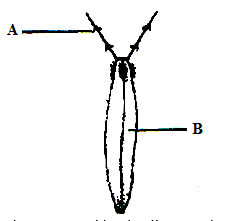
- What type of fruit represented by the diagram above? (1 Mark)
- Name each of the parts labeled A & B (2mark)
A………………………………………………………………………………………………………..
B……………………………………………………………………………………………………….. - Name the agent of dispersal of the fruit.
- In an experiment the shoot tip of a young tomato plant was decapitated as shown in the diagram below.
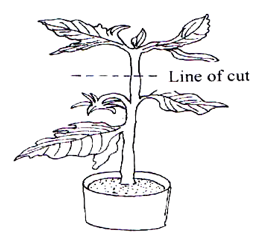
- State the expected results after 2 weeks (1 Mark)
- Give a reason for your answer in (a) above (1 Mark)
- Study the graph below and answer questions that follow.
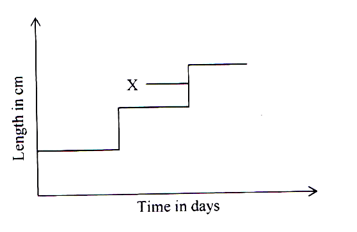
- What is the name given to the type of graph? (1 Mark)
- What is the name used to describe point X. (1 Mark)
- State the importance of part X (1 Mark)
MARKING SCHEME
- Name the tissues whose cells are thickened with:
- Cellulose and pectin (1 Mark)
- Collenchyma;
- Lignin (1 Mark)
- Sclerenchyma;
- Cellulose and pectin (1 Mark)
-
- Name parts labeled A and B (2 Marks)
- A - Sori; Rej. Sorus
- B – Rhizome;
- To which division does the plant belong? (1 Mark)
- Peridophyta;
- Name parts labeled A and B (2 Marks)
- State three measures that can be taken to control infection of man by protozoan parasites. (3 Marks)
- Improving sanitation/hygiene; using insecticides to kill vectors; avoiding indiscriminate sexual intercourse; clearing bushes/tall grass around the house; draining stagnant water; proper disposal of household refuse;
- Explain how the following factors hinder self-pollination in plants:
- Protogyny (1 Mark)
- Stigma matures earlier and is ready to receive pollen grains before the hunters are ready;
- Dioecism (1 Mark)
- Male and female gametes occur in separate plants;
- Protogyny (1 Mark)
- Explain the likely effect of humans and other organisms of untreated sewage discharged into water body that supplies water for domestic use. (2 Marks)
- Contains disease – causing micro-organisms which may cause outbreak of water borne diseases; faecal material is broken down by saprophytes leading to depletion of dissolved oxygen thus suffocation of aquatic organisms; breakdown of matter releases nutrients which enrich the water resulting in eutrophication;
- State the structural adaptation of the mitochondrion. (2 Marks)
- Inner membrane highly folded/has cristae to provide large surface area for respiratory reaction;
-
- Define the term immunity. (1 Mark)
- Ability of the body to identify/recognize foreign antigens and develop mechanisms of destroying them/ability to resist infection;
- Distinguish between natural immunity and acquired immunity. (1 Mark)
- Natural immunity is inborn/inherited/passed from parents to offspring while acquired immunity is
obtained in life;
- Natural immunity is inborn/inherited/passed from parents to offspring while acquired immunity is
- Identify one immunizable disease in Kenya. (1 Mark)
- Tuberculosis; Poliomyelitis; diphtheria,whooping cough; measles;
- Define the term immunity. (1 Mark)
- State three differences between osmosis and active transport. (3 Marks)
- Osmosis involves movement of water/solvent molecules, active transport involves movement of solute molecules; osmosis does not require energy, active transport requires energy; in osmosis molecules move along a concentration gradient, in active transport molecules move against a concentration gradient;
-
- Name the fluid found in the part labeled Q. (1 Mark)
- Glomerular filtrate;
- Identify the process responsible for the formation of the fluid named in (a) above. (1 Mark)
- Ultra-filtration/pressure filtration;
- Which two hormones exert their effect in the nephron? (2 Marks)
- Antidiuretic hormone/vasopressin; Aldosterone;
- Name the fluid found in the part labeled Q. (1 Mark)
- State three characteristics of members of kingdom Monera that are not found in other kingdoms.(3 Marks)
- Nucleus lack nuclear membrane/organelles not membrane bound; nucleus not organized; mitochondria absent/most organelles absent; cell wall made of mucoprotein;
- What is meant by the following biological terms?
- Crenation (1 Mark)
- Shrinking of red blood cells/animal cells as a result of water loss by osmosis (when placed in hypertonic solution);
- Haemolysis (1 Mark)
- Bursting of red blood cells as a result of uptake of water by osmosis(when placed in hypotonic solution);
- Plasmolysis (1 Mark)
- Shrinking and pulling away of the cell membrane from the cell wall of plant as a result of water loss by osmosis;
- Crenation (1 Mark)
-
- Name the parts labeled Q, R and S. (3 Marks)
- Q – Antipodal cell(s);
- R – Polar nucleus/body
- S – Functional egg cell;
- State the function of the pollen tube. (1 Mark)
- Pathway through which male nuclei reach the embryo sac/improves efficiency of fertilization; its tip produce lytic enzyme which dissolves the embryo sac wall to allow entry of male nuclei;
- Name the parts labeled Q, R and S. (3 Marks)
-
- State the major factor in the “Global warming) experienced in the world today.
- Carbon (IV) Oxide Rej. Carbon (iv) Oxide
- Suggest two ways of reducing Global warming. (2 Marks)
- Reducing use of wood/fossil fuels; planting more trees/afforestation or re-afforestation;
- State the major factor in the “Global warming) experienced in the world today.
- Explain how the spread of malaria is controlled by the following methods.
- Appying oil on stagnant water. (2 Marks)
- Cuts oxygen supply to the mosquito larvae; killing them by suffocation;
- Replacing male anopheles mosquito with sterile males. (2 Marks)
- Reduces members of the mosquitoes; as no more are added as the females cannot be fertilized by the sterile males;
- Appying oil on stagnant water. (2 Marks)
-
- Explain how the following adaptation of xerophytes assist them to survive in their habitat.
- Sunken stomata (1 Mark)
- Allows water vapour/moisture to saturate in the pits depression thus decreasing the diffusion gradient which reduces loss of water by transpiration;
- Thick cuticle (1 Mark)
- Increase diffusion distance reducing loss of water by transpiration;
- Sunken stomata (1 Mark)
- State the structural differences between the root system of the xerophytes and that of the hydrophytes (2 Marks)
- Xerophytes have deep/long roots to reach water table; hydrophytes have poorly developed root system;
- Explain how the following adaptation of xerophytes assist them to survive in their habitat.
-
- Name a protein and vitamin involved in blood clotting.
- Protein (1 Mark)
- Fibrinogen;
- Vitamin (1 Mark)
- Vitamin K;
- Protein (1 Mark)
- Explain why blood is not normally used for transfusion after one month. (1 Mark)
- Most of the red blood cells will have died;
- Name a protein and vitamin involved in blood clotting.
-
- What does the string X and Y represent. (2 Marks)
- X – External intercostals muscles;
- Y – Internal intercostals muscles;
- What is the effect of pulling string X (1 Mark)
- Causes the rib and the sternum to move upwards;
- What does the string X and Y represent. (2 Marks)
- State two features in the insect pollinated flowers that encourage cross pollination. (2 Marks)
- Heterostyl/stigma longer than the stamen, Protandry/stigma mature earlier than anthers; Protogny/stamen mature earlier than the stigma. Monoecous condition; any three
-
- What scientific concept was being investigated? (1 Mark)
- Photosynthesis;
-
- Give the results likely to be obtained after starch test for A and B.
- A -Negative test/starch absent; (1 Mark)
- B -Positive test/starch present; (1 Mark)
- sodium hydroxide absorbed all the carbon (iv) oxide hence no photosynthesis; (1mk)
- Give the results likely to be obtained after starch test for A and B.
- Why was leaf C included in the set-up? (1 Mark)
- Control experiment;
- What scientific concept was being investigated? (1 Mark)
-
- Explain the importance of transport in plants. (2 Marks)
- Supplies water and mineral ions to the (photosynthetic) cells; conduct products of photosynthesis/ nutrients to all parts of the plant/translocation;
- What is the role of root hairs in plants? (1 Mark)
- Absorption of water and mineral ions from the soil;
- Explain the importance of transport in plants. (2 Marks)
-
- Identify the source of urea that is removed via the kidneys in healthy human being. (1 Mark)
- Deamination of excess proteins/amino acids in the liver;
- Explain why a pregnant woman excretes less urea compared to a woman who is non-pregnant (2 Marks)
- Amino acids are used in the formation of foetal tissues; thus has less excess to be eliminated;
- Identify the source of urea that is removed via the kidneys in healthy human being. (1 Mark)
-
- What biological processes are A and B (2 Marks)
- A – Condensation
- B - Hydrolysis
- Identify the product Y. (1 Mark)
- Sucrose
- State the bond represented by X. (1 Mark)
- Glycosidic;
- What biological processes are A and B (2 Marks)
- Explain the events of the light stage of photosynthesis (3 Marks)
- Light energy is absorbed by chlorophyll molecules; used to split water molecule into oxygen and hydrogen atoms/ions; light energy is converted into chemical energy (ATP) and stored;
- Explain what happens in humans when concentration of glucose in the blood rises above the normal level. (3 Marks)
- Insulin is produced which increases oxidation of glucose; facilitate conversion of glucose into glycogen/fats for storage; inhibits conversion of glycogen into glucose;
-
- cypsela; (1 Mark)
- Name each of the parts labeled A & B
- A – Hook;
- B - Pericarp;
- Name the agent of dispersal of the fruit.
- Animal;
-
- State the expected results after 2 weeks (1 Mark)
- The auxiliary/lateral buds will sprout/branches formed or form;
- Give a reason for your answer in (a) above (1 Mark)
- Decapitation removes the hormone/IAA/Auxins which is produced in the terminal bud/stem tip;
- Absence/removal of the hormone auxins/IAA promotes branching/development of auxillary buds;
- State the expected results after 2 weeks (1 Mark)
-
- What is the name given to the type of graph? (1 Mark)
- Intermittent growth curve;
- What is the name used to describe point X. (1 Mark)
- Moulting
- State the importance of part X (1 Mark)
- Allows growth to take place
- What is the name given to the type of graph? (1 Mark)
Join our whatsapp group for latest updates
Tap Here to Download for 50/-
Get on WhatsApp for 50/-
Download Biology Paper 1 Questions and Answers - Form 3 End Term 3 2022 Exams.
Tap Here to Download for 50/-
Get on WhatsApp for 50/-
Why download?
- ✔ To read offline at any time.
- ✔ To Print at your convenience
- ✔ Share Easily with Friends / Students

